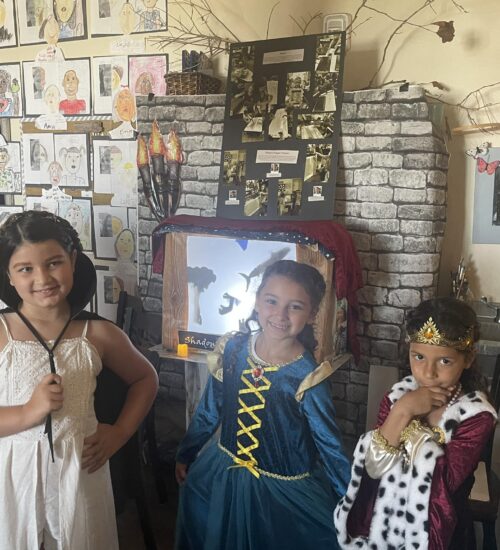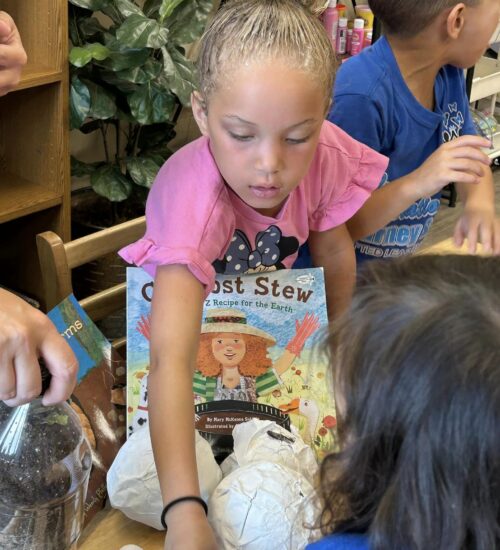In-Depth Investigations
Lessons Are Interdisciplinary and Project-Based

Interdisciplinary means several subjects are integrated into single projects. Rather than dividing lessons into “reading, spelling, writing, social studies, and math,” all subjects are integrated into every project through hands-on activities. Lessons integrate subjects in a meaningful way, just as they occur in real-world problem solving, rather than artificially isolating them. This allows students to make connections between the different subjects and the real world.
Literacy and pre-literacy, social studies (history, civilizations, geography), and math are taught through hands-on activities and projects. Projects are in-depth studies of concepts, ideas, and interests of the Scholar. Considered an adventure, projects may last one week or could continue throughout the school year.
Throughout a project, teachers help Scholars make decisions about the direction of study, ways in which the group will research the topic, methods to demonstrate and showcase the topic, and selection of materials needed for the work. Children act as researchers, guided by their teachers to find answers to their questions.
The secret of good teaching is to regard the child’s intelligence as a fertile field in which seeds may be sown, to grow under the heat of flaming imagination.- Loris Malaguzzi
Students as Researchers
It is important to utilize traditional curriculum programs and approaches to education. However, it is equally important to engage in interdisciplinary methods of instruction through research.
Revolant teaches educators to provide opportunities for students to engage in both short and long term studies. Teachers collaborate on the process of analyzing data collected over time in the classroom to develop the curriculum, helping determine which experiences and studies the Scholars will engage in. This is based on both state standards and student interest. Research projects are intentional, organized, well thought out, collaborative, and open to experimentation. Even applied to real world experiences.
Inquiry-based teaching is an essential aspect of the Reggio approach to education. Scholars are continually asked to engage in creative and critical thinking that involves analyzing, abstract thought, the consideration of hypothetical situations and that make use of metaphors and figurative language. Revolant encourages Scholars to engage in the cycle of inquiry, understanding that the process is more important than the product. The best researchers and scientists always fail first in order to succeed!
“Our task as educators, is to provide students with the tools to construct their own knowledge, rather than simply teaching rote memorization.” -Loris Malaguzzi-

In-Depth Studies & Investigations.... A Study of....
Entrepreneurship
A business research project by preschool students presents just that.
Can you believe that 4 year olds are capable of such complex lessons? This is a school that we founded, operated and managed for over a decade.
Brief Project Example: In this video, pre-k students began the investigation of how to operate a business. They integrated standards from all subjects (math, science, ELA and social studies) as they researched their topic. They ended their culminating project with a store selling the items they made. We can help you teach your educators how to utilize Project-Based learning, Inquiry-Based learning, Reggio Inspired philosophies and standard integration.
The Lost Tribes of Florida
A Calusa tribe research project by 4th graders presents just that.
The video above shows an example of one of the many long-term investigations done at a school that we founded, operated and managed.
Brief Project Description: Students created a museum that introduced people to the lost tribes of Florida. Throughout the project, they integrated every discipline (math, science, social studies and language arts). They researched the different tribes, wrote narrative biographies as though they were in that era, discussed natural resources, incorporated technology, researched explorer routes, studied the animals, environment, trade methods, utilized math on graphs as they proportionately determined the size of their villages to scale and analyzed how the villages were organized including the terrains, bodies of water. The learning and standard integration was endless.
Natural Selection
A research project by 7th graders presents just that.
The video shows the dinosaur that was made from natural materials during a long term investigation at a school that we founded, operated and managed. Look how real it looks??
Brief Project Description: The students investigated the topic in many ways such as watching a movie, reading and writing about Natural Selection. The integrated standards from every subject as they identified, drew and described evolutionary relationships between a collection of reptiles that lived during the Mesozoic Era and those that shared a common reptilian ancestor that lived earlier – in the Paleozoic Era. Students made a Cladogram (evolutionary tree) and then sketched each dinosaur.
A Study of Natural Selection... Standards Integration
Think of the critical thinking concepts and standards met while involved in this research project!! While Italy does not use “standards” in their learning, the United States does. Look at some of the many, many standards the 7th grade scholars learned while participating in this research project?
SOME are as follows:
- Create imaginative works to include background knowledge or information from other subjects.
- Follow directions and complete art tasks in a timely manner to show development of 21st century skills.
- Use non-traditional thinking and various techniques to create two-, three-, and/or four-dimensional artworks.
- Read and comprehend grade-level complex texts proficiently.
- Use appropriate collaborative techniques and active listening skills when engaging in discussions in a variety of situations.
- Recognize that fossil evidence is consistent with the scientific theory of evolution that living things evolved from earlier species.
- Explore the scientific theory of evolution by recognizing and explaining ways in which genetic variation and environmental factors contribute to evolution by natural selection and diversity of organisms.
- Explore the scientific theory of evolution by relating how the inability of a species to adapt within a changing environment may contribute to the extinction of that species.
